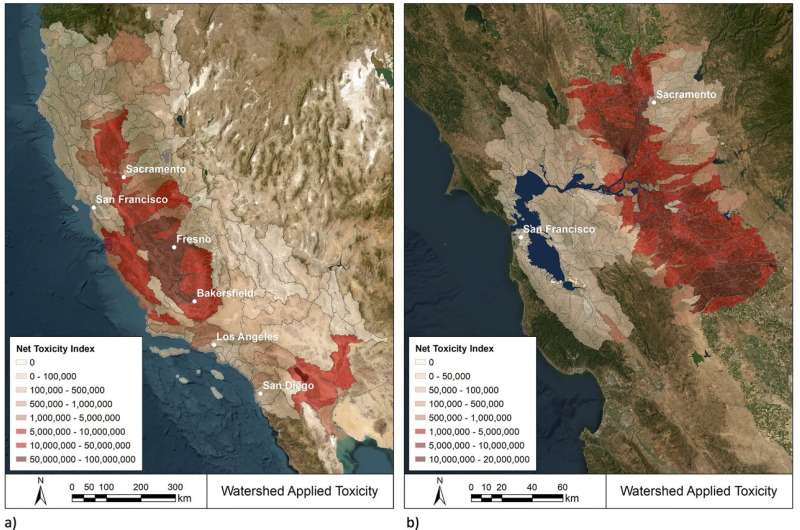This article has been reviewed according to Science X's editorial process and policies. Editors have highlighted the following attributes while ensuring the content's credibility:
fact-checked
peer-reviewed publication
trusted source
proofread
App-based tool quantifies pesticide toxicity in watersheds, identifies mitigation opportunities

Pesticides are a leading source of chemical hazards in aquatic environments. A study published in PLOS Water by Nicol Parker and Arturo A Keller at University of California, Santa Barbara, and colleagues introduces a new tool to help evaluate toxicity at high resolution and suggests that targeting a small number of pesticides in a few watersheds could significantly reduce aquatic toxicity in California's agricultural centers.
Reducing pesticide toxicity in watersheds is limited by the ability to quantify pesticide use, toxicity, and impacts over spatial and temporal scales. In order to provide a framework for targeting pesticide reductions, the authors developed the Environmental Release Tool (ERT) using watershed data from the US Geological Survey. ERT is a web and desktop application that summarizes pesticide applications and toxicity by watershed.
They used ERT to analyze pesticide use across 140 California watersheds receiving agricultural pesticide applications. The ERT was able to quantify the toxicity released to aquatic taxa across these watershed areas, representing approximately 20% of the pesticide mass in the United States and covering hundreds of commodities.
The ERT demonstrated that mitigation actions on just two pesticides and sixteen site types would affect about 90% of applied toxicity to fish, aquatic invertebrates, nonvascular plants, and vascular plants in California's agricultural landscapes. The study also showed that 20% of agricultural watersheds account for 80% of applied toxicity, suggesting that targeting a small number of watersheds receiving high concentrations of pesticides could be effective in reducing overall applied chemical toxicity. The tool has some important limitations—for example, it does not predict risks to human health or watershed ecologies, only opportunities to decrease pesticide toxicity.
According to the authors, "Our study developed the Environmental Release Tool (ERT) to provide an integrated framework for targeting pesticide toxicity reductions. Results indicate that the ERT can be a valuable tool for identifying pesticide environmental toxicity and should be considered in future agricultural management strategies."
The authors add, "The applied toxicity of agricultural pesticides in California is dominated by a handful of pesticides, and a few crops like almonds and other nuts. Careful selection of less toxic pesticides for the same crops can drastically reduce overall applied toxicity in California, and probably around the world."
More information: Leveraging high spatiotemporal resolution data of pesticides applied to agricultural fields in California to identify toxicity reduction opportunities, PLOS Water (2023). DOI: 10.1371/journal.pwat.0000124
Journal information: PLOS Water
Provided by Public Library of Science





















